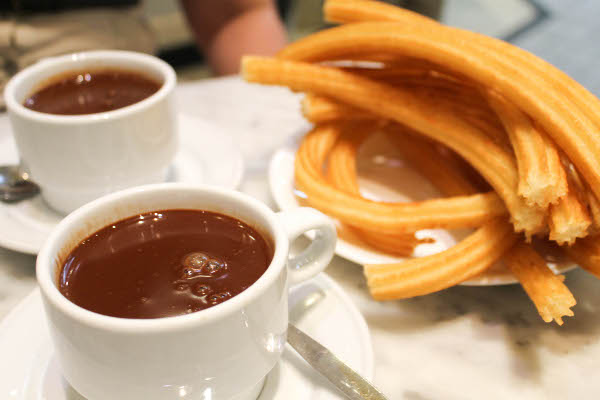What should we desayunar (have for breakfast)?
Desayunar is literally the Spanish verb of "to breakfast". (I love how they have different verbs for different meals!)
I mean practically speaking you can eat whatever you want for breakfast. But in this post, I am going to share the most typical breakfast that Spaniards eat, and most importantly, what and how you can order them.

When people think about Spanish breakfast, they picture churros and thick hot chocolate. It is very typical indeed, but the truth we don't eat it all the time.
Churros and chocolate actually can be eaten anytime of the day. I would say it is more like a sweet treat especially in the winter days. I honestly have never met anyone here telling me they eat churros at least twice a week ...
 |
| Source: confessionsofachocoholic.com |
The truth is that traditionally churros are only served with white sugar with no fillings, no cinnamon, no chocolate sauce. Nothing else. However people typically drink hot chocolate with it, and we tend to dip any kind of food in our drinks (even buttered toast I can assure you).
The Spanish hot chocolate is usually very thick. There are found in designated Xocolaterias or Xurrerias (places for hot chocolates or churros) specialised in serving hot chocolate with churros and sweet pastries, and they are often not available in normal bars and cafés. The reason why it is so thick is that they tend to put corn or normal wheat flour in it. Therefore it is thick but not sickly as the French chocolat chaud.
Pastries
Pastries is a big thing and you can find them not only in Hornos / Panaderías (bakeries), but they are often found in bars and cafés as well.
As mentioned in my previous post about Spanish pastries, you find them in all forms, both savouries and sweet, but they are mostly made of lard instead of butter. They are soft and airy, much lighter than the French ones.
One thing to note is that when I say cafés (in the context of Spain) I am often NOT referring to the fancy ones that charge you a coffee for 4 euros (HK$30-40). I am talking about Spanish version Cha Chaan Tang that are usually not very well decorated but they are the authentic ones with hearty food that you want to find yourself in.
Tostadas
Toasts are one of the most popular options for breakfast and we often eat is only with olive oil and salt, or/ and with grated tomato.

We all know Spain produces one of the best tomotoes in the world and they are indeed lovely on bread with olive oil and salt. You can also order them in any bars with Jamón (general cured ham) and cheese for 1-2 euros extra. You can usually ask for specific type of bread you want in bakeries but white baguette is norm.
Point to note: when you ask for Jamón, you are always referring to cured ham. If you want the pink ham (the ones that you can't figure out why they are even associated with meat), you are talking about Jamón York which is often more expensive in supermarket than the normal cured ham you find. Again don't expect gourmet quality when you order Jamón unless you are ordering Jamón Serrano or even Jamón Iberico (Serrano or Iberian Ham) but they are pretty nice and you will find nothing close for this price that you are paying here when you are outside of Spain.
Tortillas
 |
| Source: La Vanguardia |
The famous Spanish potato omelette is definitely something you can not miss. In fact people eat it with bread not only for breakfast but also for Almuerzo (a meal / snack between breakfast and lunch. This is a weird one so I will cover the topic in later blog post).
Usually the most traditional Spanish omelette only has potato, or potato and onion. The topic of whether it is better to go with or without onion is a huge debate for any Spaniards. I personally like it only with potato.
 |
| Source: content-recetas.lectura.com |
In the Spanish bars and cafés (again I mean the shabby yet authentic ones), you can normally find the original potato omelette, alongside with ones of other flavours such as Jamón y Queso (ham and cheese - the no-brainer), chorizo, mushrooms etc. There is another type of omelette called Tortilla Francesa (French omelette) which is often just egg omelette, or egg with other stuff that is NOT potato.
How to order your coffee?
Why would you even tell me how to order my coffee? Duhhh you may wonder.
The truth is, in most of the Spanish bars and cafés (not the ones for tourists or situated in the centre of Madrid), they don't have a drink menu (or any menu) but everyone knows what they want and what the bars will have. And I am telling you, in my first 6 months living in Spain, I was confused (af) and I always got super nervous everytime I order something in the bar because people expect you to know what you want. Then I was sticking in the safety zone choosing the same thing everytime ...
 |
| Source: vixdata.io |
Now I know you love your Cappuccino, Latte, Flat White etc. In Spain, unless you are in Starbucks or some fancy cafés with English menus designed for tourist (and charging you unreasonably), all of the above means Café con Leche (coffee with milk). While I am saying this, usually you can ask for more / less milk, more / less foam, depending on how you like it.
 |
| Source: eestatic.com |
If you are a fan of expresso, you can ask for Café Solo (or Corto), which is literally an expresso shot. Mind you, when you ask for just un café (a coffee) without specifying what kind of coffee you want and they don't clarify it with you, what you will get is a Solo.
You may also order Café Largo with a little bit more water (but much more concentrated than Americano) or Café Cortado with a tiny winey bit of milk.
 |
| Source: Nestle |
Another sweet choice is Café Carajillo which is café with liquor such as rum, bailey, brandy, whisky at your choice.
 |
| Source: offloadmedia.feverup.com |
One of the typical Valencian coffee is Cremaet. It is served with boiled liquor (often rum) together with sugar, lemon and cinnamon. After boiling, the alcohol is already evaporated leaving only the flavour of the liquor behind. It is a very popular choice often to be consumed later on in the day after a meal like a dessert.
I hope you have enjoyed my sharing about what Spanish people tend to desayunar (verb: to breakfast). In later blogs I will share more about the mystery of Almuerzo (the meal between breakfast and lunch) so do check it out later. See you soon!
Lots of love,
Cherrie




Comments
Post a Comment